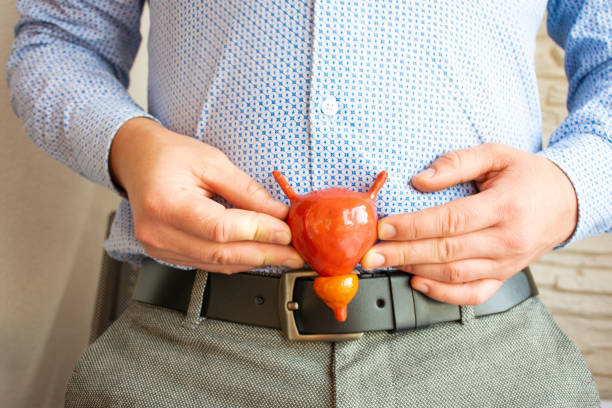Prostate enlargement, or benign prostatic hyperplasia (BPH), is a prevalent condition among aging men. Understanding the treatment options for BPH is essential for those experiencing symptoms and seeking relief. In this comprehensive guide, we will delve deeper into the various prostate enlargement treatments, providing a more detailed exploration of each option.
If you are experiencing any of these symptoms, be sure to check out this simple, at home solution to help manage your symptoms. In this eye-opening video, Dr. Daniel Brison reveals the surprising causes of enlarged prostate symptoms and his discovery that allows men to urinate like they are young again. Watch it here.
1. Lifestyle Modifications
Before delving into medical treatments, it’s important to emphasize the role of lifestyle modifications in managing BPH. Here, we’ll expand on lifestyle changes that can help alleviate symptoms:
- Dietary Modifications: A well-balanced diet rich in fruits, vegetables, whole grains, and lean protein sources can support prostate health. Specific nutrients like lycopene, found in tomatoes, and beta-sitosterol, found in nuts, have shown potential benefits. Reducing the consumption of caffeine and alcohol, particularly before bedtime, can minimize nighttime urination, a common BPH symptom.
- Regular Exercise: Incorporating regular physical activity into your routine not only promotes overall health but also helps alleviate BPH symptoms. Aim for at least 30 minutes of exercise most days of the week to maintain a healthy weight and improve urinary function.
- Hydration Management: Staying well-hydrated is essential for overall health, but it’s crucial to manage fluid intake, especially in the evening, to reduce nighttime urination frequency.
2. Medications
We’ll provide a more detailed overview of medications commonly prescribed for BPH treatment:
- Alpha-Blockers: These medications work by relaxing the smooth muscles surrounding the prostate and bladder neck. This relaxation improves urine flow and reduces symptoms such as urgency, weak stream, and hesitancy.
- 5-Alpha-Reductase Inhibitors: These drugs target the reduction of dihydrotestosterone (DHT), a hormone responsible for prostate growth. By decreasing DHT levels, 5-alpha-reductase inhibitors can reduce prostate size and alleviate BPH symptoms. It’s important to note that these medications may take several months to show their full effect.
- Combination Therapy: In some cases, healthcare providers recommend combining alpha-blockers and 5-alpha-reductase inhibitors for more comprehensive symptom relief. This combination targets both muscle relaxation and prostate size reduction.
3. Minimally Invasive Procedures
Let’s explore minimally invasive procedures in more detail:
- Transurethral Resection of the Prostate (TURP): TURP is a commonly performed surgical procedure to treat BPH. During TURP, excess prostate tissue is removed to improve urine flow. It is highly effective and has been used for many years.
- Laser Therapy: Laser techniques, such as Holmium laser enucleation (HoLEP) and GreenLight laser therapy, offer alternatives to TURP. These procedures use laser energy to remove or vaporize prostate tissue with less bleeding and a shorter recovery period.
- UroLift: UroLift is a minimally invasive procedure that uses tiny implants to hold the enlarged prostate lobes apart, reducing urethral obstruction. This procedure preserves sexual function and has a quick recovery time.
4. Surgical Interventions
When medical therapies and minimally invasive procedures are insufficient, surgical interventions may be considered:
- Open Prostatectomy: This traditional surgical approach involves a large incision to remove the enlarged portion of the prostate. It is typically reserved for very large prostates or when other procedures are not feasible.
- Robotic-Assisted Laparoscopic Prostatectomy: This minimally invasive surgical option involves smaller incisions and the assistance of robotic technology. It offers reduced pain, shorter hospital stays, and faster recovery compared to open prostatectomy.
5. Watchful Waiting
To provide a more detailed understanding of watchful waiting:
- Watchful Waiting Strategy: Watchful waiting is a conservative approach for individuals with mild BPH symptoms or specific health concerns. It involves regular monitoring of symptoms without immediate treatment. This strategy is often considered for older patients or those with comorbidities that make surgery or medication less desirable.
Prostate enlargement, or BPH, is a common concern among aging men. We’ve explored in-depth the various treatment options available, including lifestyle modifications, medications, minimally invasive procedures, surgical interventions, and the watchful waiting strategy. The choice of treatment depends on the severity of symptoms and individual health factors. Always consult with a healthcare professional to determine the best approach for your unique situation.
Remember, early diagnosis and proactive management can significantly improve your quality of life. Don’t hesitate to seek medical advice if you’re experiencing symptoms related to prostate enlargement. Your health and well-being matter, and there are effective treatments available to help you lead a comfortable and fulfilling life.
At Home Option
Taking control of your prostate health doesn’t always require medical interventions. There are effective at-home solutions that can help alleviate symptoms and enhance your overall well-being.
In this eye-opening video, Dr. Daniel Brison reveals:
- 3 Common Foods That Make You Wake Up At Night
- Why Most Prostate Health Supplements DON’T Work
- An Discovery That Allows Men To Urinate Like They’re Young Again
Watch the video now to learn how you can manage your prostate symptoms at home.
